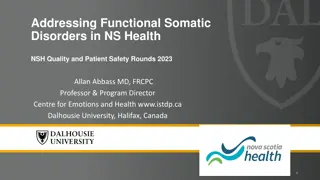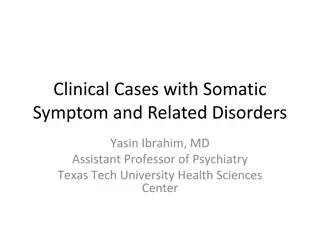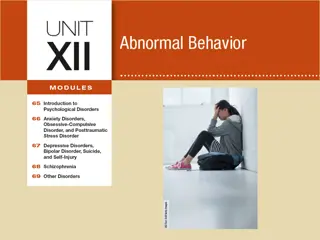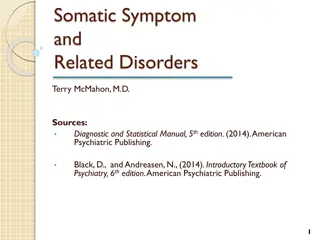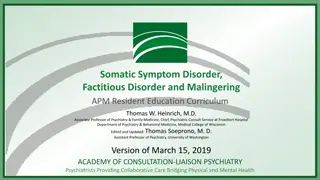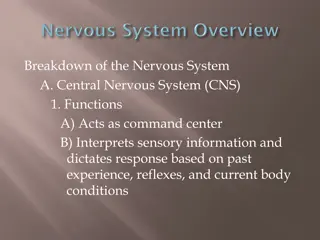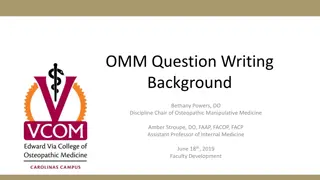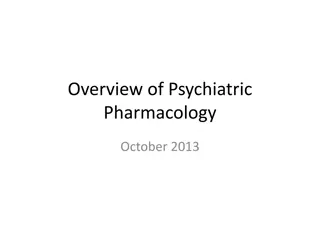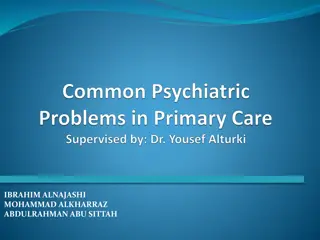
Understanding Somatic Symptom and Related Disorders
Explore the key aspects of Somatic Symptom and Related Disorders including diagnostic criteria, prevalence, risk factors, comorbidity, and more. Learn about the different types of disorders and their impact on daily life. Gain insights into the management and treatment of these conditions.
Download Presentation

Please find below an Image/Link to download the presentation.
The content on the website is provided AS IS for your information and personal use only. It may not be sold, licensed, or shared on other websites without obtaining consent from the author. If you encounter any issues during the download, it is possible that the publisher has removed the file from their server.
You are allowed to download the files provided on this website for personal or commercial use, subject to the condition that they are used lawfully. All files are the property of their respective owners.
The content on the website is provided AS IS for your information and personal use only. It may not be sold, licensed, or shared on other websites without obtaining consent from the author.
E N D
Presentation Transcript
Somatic Symptom and Related Disorders Somatic Symptom and Related Disorders Dr Mosleh S. Kareem Psychiatric Nurse and Senior Psychotherapist
Categorized the Somatic Symptom and Related Disorders: 1.Somatic symptom disorder. 2.Illness anxiety disorder. 3. Conversion disorder (functional neurological symptom disorder) 1.Factitious disorder
Somatic Symptom Disorder and Diagnostic Criteria A. One or more somatic symptoms that are distressing or result in significant disruption of daily life.
Somatic Symptom Disorder B. Excessive thoughts, feelings, or behaviors related to the somatic symptoms or associated health concerns as manifested by at least one of the following: 1. Disproportionate (unequal) and persistent thoughts about the seriousness of one s symptoms. 2. Persistently high level of anxiety about health or symptoms. 3. Excessive time and energy devoted to these symptoms or health concerns.
Somatic Symptom Disorder C. Although any one somatic symptom may not be continuously present, the state of being symptomatic is persistent (typically more than 6 months).
The prevalence of somatic symptom disorder In the general adult population may be around 5% 7%. Females more than males
Risk and Prognostic Factors Temperamental: The personality trait of negative affectivity. Comorbid anxiety or depression is common and may exacerbate symptoms and impairment. Environmental: Low socioeconomic and educational status, and in those who have recently experienced stressful life events.
Comorbidity Somatic symptom disorder is associated with high rates of comorbidity with medical disorders as well as anxiety and depressive disorders.
Illness Anxiety Disorder A. Preoccupation with having or acquiring a serious illness. B. Somatic symptoms are not present or, if present, are only mild in intensity. If another medical condition is present or there is a high risk for developing a medical condition (e.g., strong family history is present), the preoccupation is clearly excessive or disproportionate (unequal).
Illness Anxiety Disorder C. There is a high level of anxiety about health, and the individual is easily alarmed about personal health status. D. The individual performs excessive health-related behaviors (e.g., repeatedly checks his or her body for signs of illness) or exhibits maladaptive avoidance (e.g., avoids doctor appointments and hospitals).
Illness Anxiety Disorder E. Illness preoccupation has been present for at least 6 months. F. The illness-related preoccupation is not better explained by another mental disorder, such as somatic symptom disorder, panic disorder, generalized anxiety disorder, body dysmorphic disorder, obsessive-compulsive disorder, or delusional disorder.
Illness Anxiety Disorder Specify whether: Care-seeking type: Medical care, including physician visits or undergoing tests and procedures, is frequently used. Care-avoidant type: Medical care is rarely used.
Illness Anxiety Disorder 3% and 8%. The prevalence of the disorder is similar in males and females.
Illness Anxiety Disorder and Risk and Prognostic Factors Environmental: a major life stress. A history of childhood abuse or of a serious childhood illness may predispose to development of the disorder in adulthood.
Comorbidity of IAD Generalized anxiety disorder, panic disorder, and OCD) and depressive disorders. Approximately two-thirds of individuals with illness anxiety disorder are likely to have at least one other comorbid major mental disorder. Individuals with illness anxiety disorder may have an elevated risk for somatic symptom disorder and personality disorders.
Conversion Disorder (Functional Neurological Symptom Disorder) A. One or more symptoms of altered voluntary motor or sensory function. B. Clinical findings provide evidence of incompatibility between the symptom and recognized neurological or medical conditions. C. The symptom or deficit is not better explained by another medical or mental disorder. D. The symptom or deficit causes clinically significant distress or impairment in social, occupational, or other important areas of functioning or warrants medical evaluation.
Conversion Disorder and Specify symptom type: Weakness or paralysis Abnormal movement (e.g., Tremor, dystonic movement, gait disorder) Swallowing symptoms Speech symptom (e.g., Dysphonia, slurred speech) Attacks or seizures Anesthesia or sensory loss Special sensory symptom (e.g., Visual, olfactory, or hearing disturbance) Mixed symptoms
Conversion Disorder Specify if: Acute episode: Symptoms present for less than 6 months. Persistent: Symptoms occurring for 6 months or more.
Conversion Disorder and prevalence The incidence of individual persistent conversion symptoms is estimated to be 2 5/100,000 per year. Conversion disorder is two to three times more common in females.
Conversion Disorder and Risk and Prognostic Factors Temperamental: Maladaptive personality traits are commonly associated with conversion disorder. Environmental: There may be a history of childhood abuse and neglect. Stressful life events are often,
Conversion Disorder and Comorbidity Anxiety disorders, especially panic disorder, and depressive disorders commonly co-occur with conversion disorder.
Factitious Disorder Imposed on Self and Diagnostic Criteria A. Falsification of physical or psychological signs or symptoms, or induction of injury or disease, associated with identified deception. B. The individual presents himself or herself to others as ill, impaired, or injured. C. The deceptive behavior is evident even in the absence of obvious external rewards. D. The behavior is not better explained by another mental disorder, such as delusional disorder or another psychotic disorder.
Factitious Disorder Imposed on Another A. Falsification of physical or psychological signs or symptoms, or induction of injury or disease, in another, associated with identified deception. B. The individual presents another individual (victim) to others as ill, impaired, or injured. C. The deceptive behavior is evident even in the absence of obvious external rewards. D. The behavior is not better explained by another mental disorder, such as delusional disorder or another psychotic disorder.
The prevalence of factitious disorder Among patients in hospital settings, it is estimated that about 1% of individuals have presentations that meet the criteria for factitious disorder.
Differential Diagnosis (factitious disorder ) Somatic symptom disorder: In somatic symptom disorder, there may be excessive attention and treatment seeking for perceived medical concerns, but there is no evidence that the individual is providing false information or behaving deceptively. Malingering: Malingering is differentiated from factitious disorder by the intentional reporting of symptoms for personal gain (e.g., money, time off work). In contrast, the diagnosis of factitious disorder requires the absence of obvious rewards. Medical condition or mental disorder not associated with intentional symptom falsification.
Differential Diagnosis (factitious disorder ) Conversion disorder.is characterized by neurological symptoms that are inconsistent with neurological pathophysiology. Factitious disorder with neurological symptoms is distinguished from conversion disorder by evidence of deceptive falsification of symptoms. Borderline personality disorder: Deliberate physical self- harm in the absence of suicidal intent. Factitious disorder requires that the induction of injury occur in association with deception.
Nursing Interventions and Rationale for Somatic Symptom and Related Disorders 1. Nursing Interventions : Involve the client in the usual activities, self-care, eating in the dining room, and so on. Rationale: Your expectation will enhance the client s participation and will diminish secondary gain. 2. Nursing Interventions: After medical evaluation of the symptom, withdraw attention from the client s physical status except for necessary care. Avoid discussing the physical symptom; withdraw your attention from the client if necessary. Rationale: Lack of attention to expression of physical complaints will help minimize secondary gain and decrease the client s focus from the symptom.
3. Expect the client to participate in activities as fully as possible. Make your expectations clear and do not give the client special privileges or excuse him or her from all expectations due to physical limitations. 4. Do not argue with the client. Withdraw your attention if necessary. 5. Focus interactions on the client s feelings, home or work situations, and relationships. 6. Explore with the client his or her personal relationships and related feelings.
7. Teach the client and the family or significant others about somatic related disorders and how to deal with it . 8. Talk with the client about coping strategies. 9. Teach the client about stress management skills, such as increasing physical exercise, expressing feelings verbally or in a journal, or meditation techniques. Encourage the client to practice this type of technique while in the hospital.
10. Teach the client the problem-solving process: identify the problem, examine alternatives, weigh the pros and cons of each alternative, select and implement an approach, and evaluate its success. 11. Praise the client when he or she is able to discuss the physical symptom as a method used to cope with conflict. 12. Give the client positive feedback for expressing feeling and trying conflict resolution strategies.
References References DSM-5. p. 311-330 Sheila Videbeck (2017). Psychiatric Mental Health Nursing. Seven editions. P. 665-667.



